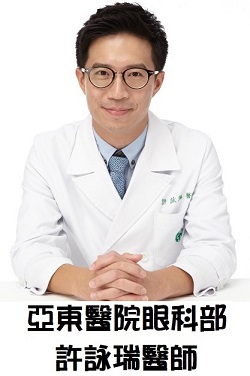10.2021 Life Guide
Seven myths of "senile macular disease"
Ophthalmology Department of Far Eastern Memorial Hospital / Dr. Xu Yongrui


 According to the statistics of the World Health Organization (who), the primary cause of blindness in developed countries is not cataract or glaucoma, but "senile macular disease". Taiwan entered the elderly society as early as 2018 and may become a super elderly society in 2026. The issue of senile macular disease has also attracted more and more attention. However, the types and treatment of such diseases are complex, which will inevitably make people confused. This article will explain your doubts through seven important questions and answers.
According to the statistics of the World Health Organization (who), the primary cause of blindness in developed countries is not cataract or glaucoma, but "senile macular disease". Taiwan entered the elderly society as early as 2018 and may become a super elderly society in 2026. The issue of senile macular disease has also attracted more and more attention. However, the types and treatment of such diseases are complex, which will inevitably make people confused. This article will explain your doubts through seven important questions and answers.Readers may have heard this dialogue:
 "Auntie looked at things a little distorted before. The doctor said it was a macular lesion and needed an injection. Moreover, one injection was not enough. It needed a lot of injections. What kind of injection is that? Can I also have an injection for the eyes?"
"Auntie looked at things a little distorted before. The doctor said it was a macular lesion and needed an injection. Moreover, one injection was not enough. It needed a lot of injections. What kind of injection is that? Can I also have an injection for the eyes?""Grandma Liao next door is also said to have macular lesions. The doctor said she would have photodynamic therapy, but what is photodynamic?"
1、 What is retina? What is macula?
Our eyes are like a precision camera. After light is refracted by the cornea and lens, it is projected on the retina to form an image signal. Therefore, the retina is like the photosensitive element of the camera. Its center is the macula. As long as we look at things, we are using it.
2、 Why does the macula get sick? It is said that there are dry and wet?
The macular region is like a high-energy factory, which provides you with visual signals every day. If it is used for a long time, it will inevitably have degenerative lesions. More serious, it will even cause ponding or bleeding in the macular region. This is macular lesions. "Dry" lesions refer to relatively slight degeneration. If the elderly over 55 years old have degenerative saphenous segments in the macula, they are of this kind. Usually, their vision is not affected and do not need special treatment. However, it is recommended to continue tracking every six months to one year. As for the "wet" lesions, they are much more serious. Abnormal neovascularization will grow in the deep layer of the retina, causing macular edema or bleeding over the years. If not treated in time, the macular will scab, resulting in permanent blindness.
 3、 What are the symptoms of macular lesions? Who are the high-risk groups?
3、 What are the symptoms of macular lesions? Who are the high-risk groups?Macular problems are characterized by vision loss starting from the center. Common symptoms include distortion of things (straight lines become curves), dark spots, breakpoints or blurs in the center. The elderly, those with family inheritance, smoking, hypertension and cardiovascular disease all belong to the high-risk group.
4、 How to maintain and control dry macular lesions?
About 10% of dry patients may turn wet, so self-assessment at home is very important. It is recommended to search the "Amsler grid" on the Internet and cover one eye at a time to observe whether the lines are distorted or dark spots. A simpler way is to take turns to observe the door frame or window frame in your home with one eye every day. If there are skews, distortions or dark spots, you should go to the eye department for medical treatment as soon as possible.
5、 How should macular lesions be treated? What drug is injected into the eye?
At present, the mainstream of treatment is intraocular injection of neovascular inhibitors. Although the health insurance has been paid since 2011, it must be submitted for trial in advance, and patients need to cooperate with long-term regular return visits. In the process, multiple injections are usually required. The initial standard course of treatment is based on the principle of one injection a month. After three injections, follow-up arrangements will be made according to the condition. Generally speaking, it is common to give more than 10 injections in the first two years.
6、 The doctor said my disease is different. It's called polypoid choroidal vascular disease. I need photodynamic therapy. What's the situation?
"Polypoid choroidal vascular disease" is a very common disease in Asia. At present, nearly half of patients with senile macular disease in Taiwan belong to this kind. Its characteristic is that there are one or several polypoid abnormal blood vessels in the choroid shaped like grapes, which may also be accompanied by abnormal blood vessels like vines. In addition to causing water accumulation, this focus often causes massive bleeding under the macula due to vascular rupture. Therefore, in terms of treatment, in addition to injecting intraocular injections of neovascularization inhibition, photodynamic therapy may also be given as appropriate to cauterize these abnormal blood vessels with laser to shrink them.
7、 How to protect eyes in daily life?
When going out, remember to wear sunglasses and hats in places with strong sunlight.
Prevention and control of three high, cardiovascular disease and other risk factors.
Eat a balanced diet and eat more dark green vegetables, nuts and deep-sea fish.
#


















